IAC News
IAC News No.28, February 2015
Japan Society of Civil Engineers International Activities Center Feb. 2, 2015 IAC News No.28
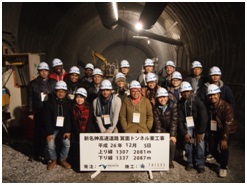 Site inspection December 5, 2014 |
2014 Annual Meeting and International Workshop of CICHE
CICHE’s 2014 Annual Meeting and International Workshop held at Garden Villa in Kaohsiung on December 7-8, 2014, at which a JSCE delegation of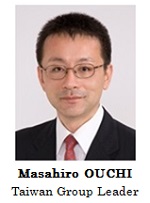 5 members, Prof. Tamon Ueda IAC Senior Director (Hokkaido University), Mr. Asao Yamakawa IAC Director, Prof. Hikaru Nakamura (Nagoya University) as one of two speakers, Ms. Ellen Wang and I attended. JSCE has nurtured a cooperative relationship and developed communication with CICHE over years, and attending each other’s annual meeting is one of the opportunities to improve mutual understanding.
5 members, Prof. Tamon Ueda IAC Senior Director (Hokkaido University), Mr. Asao Yamakawa IAC Director, Prof. Hikaru Nakamura (Nagoya University) as one of two speakers, Ms. Ellen Wang and I attended. JSCE has nurtured a cooperative relationship and developed communication with CICHE over years, and attending each other’s annual meeting is one of the opportunities to improve mutual understanding.
CICHE usually holds its Annual Meeting, which is like JSCE’s Annual Meeting combined with General Meeting, on one day in mid- to late November every year. That one-day annual meeting usually consists of Opening Ceremony, General Meeting and Special lectures in the morning, followed by Technical Discussions in the afternoon. This year they kindly pushed back the date of meeting to December, and organized as a two-day meeting so as not to conflict with JSCE’s 100th Anniversary Celebration took place in November.
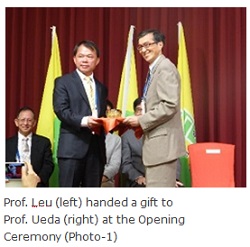 At the Opening Ceremony, the CICHE President Prof. Liang-Jenq Leu (National Taiwan University) gave Prof. Ueda (the photo below) a beautiful gift to congratulate the centennial anniversary.
At the Opening Ceremony, the CICHE President Prof. Liang-Jenq Leu (National Taiwan University) gave Prof. Ueda (the photo below) a beautiful gift to congratulate the centennial anniversary.
It is the feature of CICHE’s annual meeting that concurrent sessions are offered in a wide range of topics in the civil engineering field while research paper presentation session in each area are not offered. One of those concurrent sessions is International Roundtable Meeting which is carried out in English. This year that meeting was organized as an one-day meeting with the title “International Workshop on Improving the Influence and Internationalization of Civil Engineering Society on the second day, and the total 6 representatives of Japan, Korea and Hong Kong delivered presentations. Prof. Nakamura and Prof. Ueda discussed “JSCE Public Policy: How Civil Engineering Society can be More Effective?” and “International Cooperation in Asia for Enhancement of Technological and Educational Capacity” respectively. They attracted the audience and nicely involved them into the discussions.
Next day December 6, we went on a Technical Visit which took us to the site of Kaohsiung Metropolitan area underground railway project. That project, which would be completed in December 2017, would covert the existing Kaohsiung Station and rails into an underground station and railways and further build five underground stations.
The project should not be an easy one, requiring high-level sophisticated technology, which would develop the area situated perpendicular to the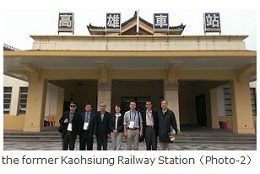 Kaohsiung Station. When we arrived at its site, large-scale underground excavation works were going on. Photo 2 shows the former Kaohsiung Railway Station, which was opened in 1941 during the Japanese Colonial rule (constructed by Shimizu Corp. in those days) and not used after the WWII. The station has been moved to nest to the site of new Kaohsiung Station and converted to The Vision of Kaohsiung Museum.
Kaohsiung Station. When we arrived at its site, large-scale underground excavation works were going on. Photo 2 shows the former Kaohsiung Railway Station, which was opened in 1941 during the Japanese Colonial rule (constructed by Shimizu Corp. in those days) and not used after the WWII. The station has been moved to nest to the site of new Kaohsiung Station and converted to The Vision of Kaohsiung Museum.
The CICHE’s annual meeting concluded with the International Workshop on Sunday the 7trh. We however continued our stay in Taiwan to go on an excursion to the Wushantou Reservoir in the afternoon. That excursion was kindly arranged by Prof. Leu and CICHE members. It was about a one-hour drive from Kaohsiung to the reservoir via Highway Route 3. We first visited Chia-Nan Irrigation Association and learned about the association’s history, Hatta Yoichi’s contribution to the development of irrigation systems in that area.
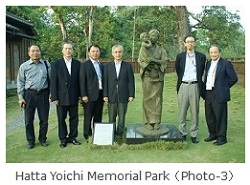 Then, that association’s staff gave us a tour to the head office and four houses for the staff which were restored to their original forms recently via Hatta Yoichi bronze statue and Memorial Hall stood in Hatta Yoichi Memorial Park (Photo 3). There will be no need to repeat the well-known Wushantou Reservoir construction here. Instead, I would like to refer that that statue was surrounded by flower bouquets as ever, and after the restoration of those structures, more visitors apparently visited to pay tribute to Mr. Hatta.
Then, that association’s staff gave us a tour to the head office and four houses for the staff which were restored to their original forms recently via Hatta Yoichi bronze statue and Memorial Hall stood in Hatta Yoichi Memorial Park (Photo 3). There will be no need to repeat the well-known Wushantou Reservoir construction here. Instead, I would like to refer that that statue was surrounded by flower bouquets as ever, and after the restoration of those structures, more visitors apparently visited to pay tribute to Mr. Hatta.
Prof. Leu told that he wanted to that reservoir because the CICHE had designated that reservoir as Civil Engineering Heritage. Even though, we were deeply grateful to him and CICHE members who took the trouble to take us to the tour on Sunday. Thank you very much.
Report on Site Inspection Tour For Overseas Students (IAC International Student Network Group)
The IAC International Student Network Group hosted a site inspection tour for overseas students in Osaka, Japan, on December 5, 2014. The tour gave overseas students studying in Japan the opportunity to learn about Japan’s latest civil engineering technologies and Japanese companies involved in civil engineering. This was the Group’s first event in the Kansai region, and overseas students at universities in the area were invited to join the tour. With the cooperation of West Nippon Expressway Company Limited, twenty overseas students visited two sites and met with representatives from five companies.
[Site inspection]
1) Shinmeishin Osaka West Office, West Nippon Expressway Company Limited
2) Minoo Tunnel East Work (contractor: Taisei Corporation)
3) Akutagawa Bridge Work (contractor: Sumitomo Mitsui Construction Co., Ltd.)
[Participant companies in company explanation meeting]
West Nippon Expressway Company Limited, Obayashi Corporation, Kajima Corporation, Taisei Corporation, and Sumitomo Mitsui Construction Co., Ltd.
The tour party first visited the Minoo Tunnel East Work construction site. After a presentation on the site’s construction technologies, the tour party went inside the tunnel and examined the tunnel face and the heavy machinery, all the while earnestly asking questions.
Next, the party visited the Akutagawa Bridge Work construction site. They climbed to the upper part of the elevated bridge, which is over 20 m from the ground. Inside the girder framework, the construction method and technologies were explained. This is a much larger project than the Minoo Tunnel East Work project and the overseas students took great interest in it.
Representatives from Japanese companies who had studied civil engineering in Japan as overseas students were present at both sites. They told the tour party not only about civil engineering technologies but also about their experiences working at construction sites.
|
|
|
Each representative from the five companies, including the owner and the contractors of the construction work, gave a ten-minute presentation at the tour sites. The tour party listened attentively to the descriptions of each company’s projects and tasks as well as the company’s overseas operations and other information. During the subsequent reception, the tour party talked with the company representatives and collected information about civil engineering technologies, the companies, etc.
Through this first event in the Kansai region, we realized anew that overseas students are very interested in these kinds of opportunities. The IAC International Student Network Group will host these events continuously (about once a year) in order to provide overseas students around Japan with opportunities to communicate with businesses. To improve future events, we will ask the participants of this first event for their opinions.
In conclusion, we would like to express our gratitude to Mr. Kunihiro Mitsui of West Nippon Expressway Company Limited and other concerned people for helping us to hold this event.
Report on Third IAC Japanese Civil Engineers Global Leaders Symposium
The JSCE IAC hosted the third IAC Japanese Civil Engineers Global Leaders Symposium on the “Pahang Selangor Raw Water Transfer Project” on December 3, 2014.
Japanese companies have constructed many large and well-known overseas projects. This symposium introduces many of Japan’s overseas projects, civil engineering technologies, and civil engineer activities. The symposium also impresses upon Japan’s young people the significance of infrastructure development, tasks overseas, etc.
Mr. Asao Yamakawa, IAC Director, opened the symposium with a speech. Mr. Masashi Matsui, from Shimizu Corporation, served as a moderator. In the first half of the symposium, Mr. Shigeru Nakamura who served as an ambassador in Malaysia that was the venue of this project gave a keynote speech. A video letter from Ms. Datuk Loo Took Gee, Vice-Minister of the Ministry of Energy, Green Technology and Water of the Malaysian government, which is the owner of the project, also was presented. In the second half, Mr. Naoki Kita, Mr. Takashi Kawata, Mr. Takayuki Matsumoto, and Mr. Fumiya Matsushita, the four civil engineers from Shimizu Corporation who had worked at the project site, gave speeches. The topics ranged from an overview of the project and the details leading up to receiving the order to the various challenges they faced in constructing the longest tunnel in Southeast Asia. Prof. Tamon Ueda, IAC Senior Director, closed the symposium with a speech.
|
|
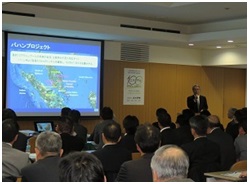 A lecturer gives a speech |
The symposium was a great success, drawing an attendance of more than 120 people. In the question-and-answer sessions, the participants lively exchanged views.
The IAC plans to continue holding IAC Japanese Civil Engineers Global Leaders Symposiums in the future focusing on overseas projects.
※Names, affiliations/titles in the above report are referred to the list of participants in those international events.
【Reported by International Activities Center】
What's Happening
● 2015/2/27・・・・・Construction Industry Global Vision Lecture Series “A Global Strategy for the Construction Industry: In Dialogue with World Leaders (The Univ. of Tokyo, Hongo Campus, Tokyo) http://committees.jsce.or.jp/kokusai/node/72
● 2015/3/27~28・・・・ACECC 28th Executive Council Meeting (ECM) in Dhaka, Bangladesh
Updates
●The summary of feature articles in the JSCE Magazine is available on the JSCE website.
http://www.jsce-int.org/pub/magazine
●Concrete Committee International Newsletter No. 38
http://www.jsce.or.jp/committee/concrete/e/newsletter/Newsletter.htm
●Journal of JSCE
The Journal of JSCE is the collection of research papers which can be viewed on the JSCE website.
https://www.jstage.jst.go.jp/browse/journalofjsce
●JSCE 100th Anniversary Postal Stamp was released in September, 2014.
http://jsce100.com/node/250(Japanese Only)
IAC News Subscription
The IAC News is one of the communication tools to share information and ideas with the members. We would like to invite you, your friends and colleagues to join the communication and to subscribe the IAC News. Please register online: (http://www.jsce-int.org/pub/registration/non-international_students). We look forward to meeting you.
Editor's postscript
I usually walk down street looking ahead, or facing up to see trees and sky, but seldom do that looking down at the ground. I rarely think what consists of the soil under my feet. Recently Geospatial Information Authority of Japan has started a new map service, to which you can access with Smartphone. You can view active faults and areas vulnerable to liquefaction. Pretty cool! But, I save myself the trouble of checking every soil which I step on; otherwise, I would not be able to walk on anymore. (Y.S)

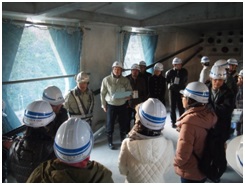
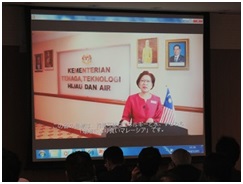 Introduction of video letter
Introduction of video letter